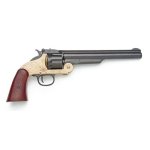Something you have GOT to watch and re-watch to appreciate. I ask you please RATE this thread when you've reviewed it. With a few more points, Lee will give me a new kitchen toaster. (NOT)
Here's Roy at this best, just doing what he DOES best !
Explaining how the better quality revolver got tossed to the side because of the proprietary .45 S&W Schofield ammo instead of making the cylinder a tad longer to accept the .45 Long Colt, too.
Not learning enough from this in 1913 S&W engineered and produced a fabulous and well functioning, reliable semi-automatic in a proprietary, .35 S&W Auto instead of the standard, common and well accepted (and available at any local hardware store) .32 ACP.
This one goes near the top of the list of S&W blunders, along with NO Caliber designations on most of the Model 3 product line until the very last few thousand.
Also, not paying Schofield a trivial royalty for his clearly improved clasp and catch for the New Model 3 revolvers that followed.
Go, ahead ... make my day ... start listing all the S&W BLUNDERS or things that could have been done better and / or differently, but first watch Roy doing his job and doing it like no one else could.
[ame]https://www.youtube.com/watch?v=ZrqPGO1-aMQ[/ame]
... and, leave it to the History Channel, the cover photo appears to be a replica American with the brass frame you see advertised everywhere as a SCHOFIELD replica.
Here's Roy at this best, just doing what he DOES best !
Explaining how the better quality revolver got tossed to the side because of the proprietary .45 S&W Schofield ammo instead of making the cylinder a tad longer to accept the .45 Long Colt, too.
Not learning enough from this in 1913 S&W engineered and produced a fabulous and well functioning, reliable semi-automatic in a proprietary, .35 S&W Auto instead of the standard, common and well accepted (and available at any local hardware store) .32 ACP.
This one goes near the top of the list of S&W blunders, along with NO Caliber designations on most of the Model 3 product line until the very last few thousand.
Also, not paying Schofield a trivial royalty for his clearly improved clasp and catch for the New Model 3 revolvers that followed.
Go, ahead ... make my day ... start listing all the S&W BLUNDERS or things that could have been done better and / or differently, but first watch Roy doing his job and doing it like no one else could.
[ame]https://www.youtube.com/watch?v=ZrqPGO1-aMQ[/ame]
... and, leave it to the History Channel, the cover photo appears to be a replica American with the brass frame you see advertised everywhere as a SCHOFIELD replica.
Attachments
Last edited:


